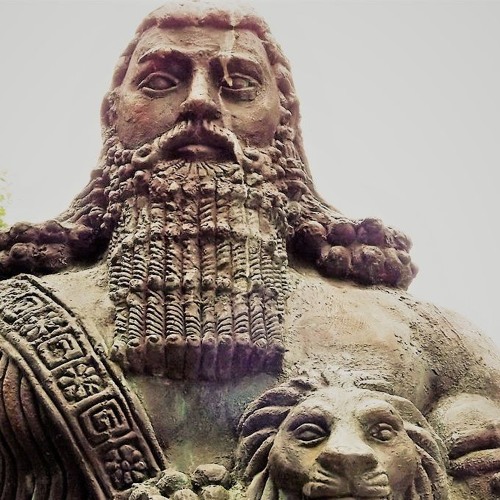Read this Post about The Epic of Gilgamesh and download the free PDF below, on this website.
Enjoy your Time while Reading. And you can also search for similar posts here on our Website if you are interested.
I. Introduction
The “Epic of Gilgamesh” is widely regarded as the oldest known epic tale, originating from ancient Mesopotamia around 2100 BCE. This literary masterpiece, inscribed on clay tablets in cuneiform script, offers a window into the values, beliefs, and concerns of early human civilizations. The epic chronicles the adventures of Gilgamesh, the semi-divine king of Uruk, and his quest for immortality. As one of the earliest examples of epic literature, the “Epic of Gilgamesh” provides profound insights into the human condition, exploring themes such as friendship, mortality, and the quest for meaning.
This blog post aims to delve into the depths of the “Epic of Gilgamesh,” examining its historical context, main plot, key characters, and enduring impact on literature and culture. We will also explore the challenges of translating and interpreting this ancient text, as well as its relevance in modern times. By the end of this post, readers will gain a comprehensive understanding of the epic’s significance and its timeless appeal.
- The “Epic of Gilgamesh” is the oldest known epic, originating from ancient Mesopotamia around 2100 BCE.
- It offers insights into the values, beliefs, and concerns of early human civilizations.
- The narrative chronicles the adventures of Gilgamesh, the semi-divine king of Uruk, and his quest for immortality.
- Themes include friendship, mortality, and the quest for meaning.
- This blog post will explore the historical context, main plot, key characters, and the epic’s impact on literature and culture.
II. Historical Context and Discovery
The “Epic of Gilgamesh” is set in ancient Mesopotamia, a region often referred to as the cradle of civilization. This area, corresponding to modern-day Iraq, Kuwait, and parts of Syria and Turkey, was home to some of the world’s earliest cities, including Uruk, where Gilgamesh is said to have ruled. The epic reflects the social, political, and religious milieu of the time, offering a glimpse into the values and concerns of early Mesopotamian society. The themes of the epic, such as the quest for immortality and the struggle against fate, resonate with the existential questions faced by humanity across ages.
The discovery of the “Epic of Gilgamesh” in the 19th century was a monumental event in the field of archaeology and ancient studies. British archaeologist Austen Henry Layard and his team unearthed the clay tablets in the ruins of the ancient library of Ashurbanipal in Nineveh. The deciphering of the cuneiform script revealed a sophisticated narrative that predated other ancient texts, such as the Iliad and the Bible. This discovery not only expanded our understanding of Mesopotamian literature but also highlighted the interconnectedness of ancient civilizations through shared stories and themes.
- Set in ancient Mesopotamia, the cradle of civilization, corresponding to modern-day Iraq and surrounding areas.
- Reflects the social, political, and religious milieu of the time.
- Themes of immortality and fate are central to the narrative.
- Discovered in the 19th century by archaeologist Austen Henry Layard.
- Unearthed in the ancient library of Ashurbanipal in Nineveh, revealing a sophisticated narrative predating other ancient texts.
III. Summary of the Epic
The “Epic of Gilgamesh” follows the adventures of its titular hero, Gilgamesh, who is two-thirds god and one-third human. The narrative begins with Gilgamesh’s tyrannical rule over Uruk, which leads the gods to create Enkidu, a wild man destined to become Gilgamesh’s companion and counterbalance. After a fierce battle, Gilgamesh and Enkidu become close friends and embark on a series of heroic quests, including the defeat of the monster Humbaba and the Bull of Heaven, sent by the goddess Ishtar as punishment for Gilgamesh’s rejection of her advances.
Tragedy strikes when Enkidu is cursed by the gods and dies, plunging Gilgamesh into profound grief and sparking his quest for immortality. Gilgamesh’s journey takes him to the ends of the earth, where he encounters Utnapishtim, the survivor of a great flood who was granted eternal life by the gods. Through his adventures, Gilgamesh learns about the inevitability of death and the importance of accepting one’s mortality. The epic concludes with Gilgamesh returning to Uruk, wiser and more at peace, having learned to find meaning in his human limitations.
- Follows the adventures of Gilgamesh, two-thirds god and one-third human.
- Begins with Gilgamesh’s tyrannical rule and the creation of Enkidu as his companion.
- Gilgamesh and Enkidu embark on quests, defeating Humbaba and the Bull of Heaven.
- Enkidu’s death spurs Gilgamesh’s quest for immortality.
- Gilgamesh learns about mortality and returns to Uruk wiser and more at peace.
IV. Character Analysis
Gilgamesh, the epic’s central figure, undergoes significant character development throughout the narrative. Initially portrayed as a tyrannical and self-absorbed king, Gilgamesh’s encounters with Enkidu and his subsequent quest for immortality transform him into a wise and introspective leader. His journey reflects the universal human quest for self-discovery and the struggle to reconcile with the inevitability of death. Gilgamesh’s evolution from a despot to a hero highlights the themes of growth, friendship, and the pursuit of wisdom.
Enkidu, created by the gods as a counterbalance to Gilgamesh, plays a crucial role in the epic. Originally a wild man living among animals, Enkidu’s transformation begins with his encounter with Shamhat, a temple prostitute who introduces him to human civilization. Enkidu’s friendship with Gilgamesh is central to the narrative, providing both companionship and a moral compass for the king. Enkidu’s death serves as the catalyst for Gilgamesh’s quest for immortality, underscoring the themes of loss, companionship, and the fleeting nature of life. Other significant characters, such as Utnapishtim and the gods, further enrich the epic’s exploration of human and divine interactions.
- Gilgamesh transforms from a tyrannical king to a wise and introspective leader.
- His journey reflects the universal quest for self-discovery and reconciliation with mortality.
- Enkidu, initially a wild man, becomes Gilgamesh’s close friend and moral compass.
- Enkidu’s death catalyzes Gilgamesh’s quest for immortality.
- Other characters, like Utnapishtim and the gods, enrich the narrative’s exploration of human and divine interactions.
V. Themes and Motifs
The “Epic of Gilgamesh” is rich with themes that have universal relevance. One of the most prominent themes is the quest for immortality. Gilgamesh’s journey to find eternal life reflects humanity’s deep-seated fear of death and the desire to transcend it. Through his interactions with Utnapishtim and his ultimate acceptance of mortality, the epic conveys a poignant message about the inevitability of death and the importance of living a meaningful life.
Another significant theme is the transformative power of friendship. The bond between Gilgamesh and Enkidu is a central element of the narrative, highlighting the value of companionship and mutual support. Their friendship not only transforms Gilgamesh from a tyrant into a wise ruler but also emphasizes the importance of human connections in facing life’s challenges. The motif of dreams and visions is also recurrent in the epic, serving as a means of divine communication and forewarning. These themes and motifs contribute to the epic’s enduring appeal, resonating with readers across different cultures and eras.
- Quest for immortality reflects humanity’s fear of death and desire to transcend it.
- Transformative power of friendship is central, highlighting the value of companionship.
- Dreams and visions serve as divine communication and forewarning.
- Themes of mortality, wisdom, and acceptance are prominent.
- Motifs contribute to the epic’s universal and enduring appeal.
VI. Mythological and Religious Aspects
The “Epic of Gilgamesh” is deeply embedded in the mythological and religious beliefs of ancient Mesopotamia. The gods play a pivotal role in the narrative, influencing the fate of the characters and the outcome of events. The interaction between humans and gods in the epic reflects the Mesopotamian worldview, where divine forces were believed to govern every aspect of life. The story of the great flood narrated by Utnapishtim, which parallels the biblical account of Noah’s Ark, is one of the most significant mythological elements in the epic.
The religious aspects of the epic are evident in the rituals, prayers, and offerings depicted throughout the narrative. Gilgamesh’s journey to meet Utnapishtim includes passing through sacred realms and encountering divine beings, highlighting the spiritual dimensions of his quest. The epic also addresses existential questions about life, death, and the afterlife, reflecting the Mesopotamian belief in an afterlife governed by the gods. These mythological and religious elements enrich the narrative, providing a deeper understanding of the ancient cultural and spiritual context.
- Deeply embedded in Mesopotamian mythological and religious beliefs.
- Gods influence characters’ fates and the narrative outcome.
- Reflects Mesopotamian worldview of divine forces governing life.
- The great flood story parallels the biblical account of Noah’s Ark.
- Religious rituals, prayers, and offerings are depicted throughout.
VII. Impact on Literature and Culture
The “Epic of Gilgamesh” has had a profound influence on literature and culture, serving as a foundational text for subsequent epic narratives. Its themes of heroism, friendship, and the quest for immortality have resonated through the ages, inspiring works such as Homer’s “Iliad” and “Odyssey.” The epic’s influence extends to modern literature, where its archetypal characters and motifs continue to appear in various forms. The narrative’s exploration of universal human concerns has ensured its relevance and enduring appeal.
In addition to its literary impact, the “Epic of Gilgamesh” has influenced cultural and philosophical thought. The epic’s portrayal of the human condition, with its emphasis on the pursuit of meaning and the acceptance of mortality, resonates with existentialist themes explored by modern philosophers. The story of Gilgamesh’s transformation from a tyrant to a wise king offers insights into leadership and personal growth, making it a valuable text for understanding ancient and contemporary human experiences. The epic’s legacy is evident in its continued study and appreciation across different cultures and time periods.
- Foundational text for subsequent epic narratives, influencing works like the Iliad and the Odyssey.
- Archetypal characters and motifs appear in modern literature.
- Explores universal human concerns, ensuring its relevance.
- Inspires modern philosophical and existential thought.
- Offers insights into leadership, personal growth, and human experiences.
VIII. Translation and Interpretation Challenges
Translating and interpreting the “Epic of Gilgamesh” presents significant challenges due to its ancient origins and the complexity of the cuneiform script. The tablets on which the epic was inscribed are fragmented, leading to gaps and uncertainties in the text. Scholars have worked meticulously to reconstruct the narrative, but variations in translation can result in different interpretations of key passages. The nuances of the original Akkadian language, with its poetic and symbolic expressions, add another layer of complexity to the translation process.
Different versions of the epic, discovered in various Mesopotamian cities, further complicate the task of creating a definitive translation. Each version contains unique elements and variations in the story, reflecting the evolving nature of oral and written traditions. Scholars debate the meanings and significance of these differences, contributing to an ongoing scholarly discourse about the epic’s interpretation. Despite these challenges, the efforts to translate and understand the “Epic of Gilgamesh” continue to provide valuable insights into ancient literature and human thought.
- Ancient origins and cuneiform script complexity present significant challenges.
- Fragmented tablets lead to gaps and uncertainties in the text.
- Variations in translations result in different interpretations.
- Nuances of the original Akkadian language add complexity.
- Different versions of the epic discovered across Mesopotamia further complicate translation efforts.
IX. Legacy and Modern Relevance
The “Epic of Gilgamesh” remains a timeless and relevant text, offering profound lessons for contemporary readers. Its exploration of themes such as mortality, friendship, and the quest for meaning resonates with universal human experiences. The epic’s portrayal of Gilgamesh’s transformation from a self-centered ruler to a wise and compassionate leader provides valuable insights into personal growth and leadership. The narrative encourages readers to reflect on their own lives and the ways in which they seek meaning and fulfillment.
In modern times, the epic’s relevance extends to various fields, including literature, psychology, and philosophy. Its existential themes and archetypal characters continue to inspire creative works and scholarly research. The “Epic of Gilgamesh” also offers a historical perspective on the evolution of storytelling and the ways in which ancient cultures grappled with fundamental human concerns. By engaging with this ancient text, readers can gain a deeper understanding of the continuity and change in human thought across millennia. The epic’s lessons on mortality and the human condition remain as pertinent today as they were in ancient times, providing timeless wisdom and perspective.
Moreover, the epic’s reflections on leadership, friendship, and the pursuit of knowledge offer valuable insights for contemporary society. Gilgamesh’s journey teaches the importance of compassion, humility, and the recognition of our shared humanity. In a world that often seems fragmented and divided, the “Epic of Gilgamesh” reminds us of the enduring values that bind us together and the universal quest for meaning that transcends cultural and temporal boundaries.
- Timeless and relevant text, offering profound lessons on mortality, friendship, and the quest for meaning.
- Gilgamesh’s transformation provides insights into personal growth and leadership.
- Relevant to literature, psychology, and philosophy with its existential themes.
- Offers a historical perspective on storytelling and ancient cultural concerns.
- Encourages reflection on modern human experiences and values.
X. Conclusion
The “Epic of Gilgamesh” stands as a monumental work in the annals of world literature, bridging the gap between ancient and modern times with its profound exploration of human nature and existential themes. As the oldest known epic, it not only provides a historical snapshot of early Mesopotamian civilization but also serves as a timeless narrative that continues to inspire and educate. Its themes of mortality, friendship, and the search for purpose resonate across cultures and eras, underscoring the universality of the human experience.
In conclusion, the “Epic of Gilgamesh” invites readers to embark on a journey of self-discovery and reflection, much like its protagonist. By delving into its rich narrative and complex characters, we gain a deeper appreciation for the ancient roots of storytelling and the timeless questions that continue to define our existence. Whether read for its literary merits, historical insights, or philosophical wisdom, the “Epic of Gilgamesh” remains an indispensable part of our cultural heritage, offering valuable lessons for future generations.
- The “Epic of Gilgamesh” bridges ancient and modern times with its exploration of human nature.
- Provides historical insights and serves as a timeless narrative.
- Themes of mortality, friendship, and purpose resonate across cultures and eras.
- Invites readers to reflect on personal growth and the search for meaning.
- Remains an indispensable part of cultural heritage, offering valuable lessons for future generations.
For those interested in delving deeper into the teachings of the Emerald Tablets, a variety of books and articles are available here.






